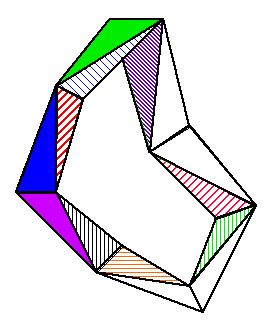2004 Jeffrey Scott Longstaff
Rudolf Laban’s (1966) method of “choreutics”, also called “space harmony” remains one of the most intriguing areas of his work, utilising geometric forms, polyhedra, also known as ‘platonic solids’ to map movement forms in space. Somehow these symmetrical designs inspire our curiosity and imagination about the nature of physical reality itself.
One of Laban’s least understood choreutic creations could be described as a seven-link movable chain, consisting of a series of seven tetrahedra, linked together into a closed circuit.

The greatest amount of published writing on the seven-link chain is found in Laban’s book Choreutics (Laban, 1966, p. 120-122). Here, Laban devised a “diaformic scale” of seven movements which corresponded to the “diatonic scale” of seven intervals in music. In the same way that the seven intervals of the musical diatonic scale can be transposed to different keys, the seven movements of Laban’s diaformic scale can be rotated into different orientations.
The diatonic musical scale progresses through a seven-part series of whole-step and half-step intervals:
DO whole-step RE whole-step ME half-step FA whole-step SO whole-step LA whole-step TEE half-step DO
In this same way, the diaformic movement scale progresses through a series of narrow angles and wider angles. Angles between movements are analogous to intervals between musical tones, of half-steps (narrow angles) and whole-steps (wide angles). This series of narrow angles and wide angles can be seen in the model of the seven-link chain.